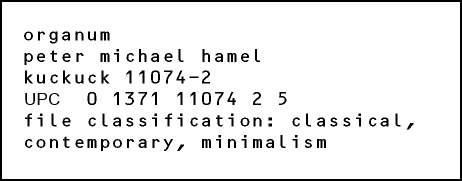 |
|||||||||||||||
 
Meditative Kompositionen/Improvisationen für
Pfeifenorgel, aufgeführt 1985 von Hamel in der
Münchner Musikhochschule. Minimalistische Strukturen über
mächtigen Grundtönen, der Klangraum mittelalterlicher
Kathedralen, ergreifende Bilder.
the projectRenowned German composer Peter Michael Hamel turned his focus to the pipe organ for his dramatic composition, Organum. The four-part score is based on the medieval music form, the organum.In Latin, the term organum has two meanings; it either refers to the organ or to the polyphonic Gregorian chant. Hamel combines the two meanings as he masterfully performs on the grand pipe organ at the Academy of Music in Munich, his instrument taking the place of the human voice. The polyphonic form of organum came to its height in 12th century Paris, with composers associated with the Notre-Dame Cathedral. Their settings contained contrasting sections; voices rhythmically patterned, discantus style, alternating with sections in which the chant notes were prolonged to accommodate the many notes sung above them, organal style. Hamel incorporates these contrasting sections in the four parts of Organum, an inspired and moving performance by this artist and composer. the artistBorn in Germany in 1947, Peter Michael Hamel is not only a student of music (The State Academy of Music, Munich, and Munich University) but of sociology and psychology as well. It is that wonderful combination that gives Hamel's music the depth of humanism that is so evident.Hamel has an intense interest in oriental traditions, exploring the meditative use of music as a bridge between East and West. His book, Through Music to the Self, explores his theories of music as a means of understanding one's self, while reflecting on his studies of Indian vocal styles and ethnic tonal systems. biographydiscographytracklist
|
|||||||||||||||
|
|
|||||||||||||||
 |


